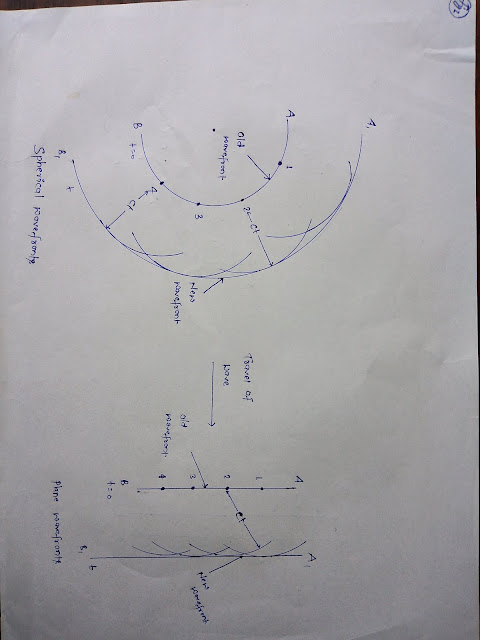Huygens principle stats that every point on the given wavefront acts as a secondary source of light ( or source of secondary wave called secondary wavelets) which travels in all the direction even backward with the velocity of light in that given medium.
wavefront is detailed explained in the last of the page.
Huygens principle Explained in detail
Huygens principle is a geometrical construction for finding the location of new wavefront at the same time, from the [position of previous wavefront this can be stated as in detail.
1. Every point on a given or previous wavefront acts as a secondary source of light or secondary wavelets.
2. The position of new wavefront can be determined by drawing a large surface touching tangentally to the surface of all secondary wavelets in the forward direction.
Huygens construction
The above picture shows the Huygens principle of geometrical construction for determining the position of new wavefront.
Explanation of Huygens principle from above picture.
first consider the diversing spherical wave moving in a medium, At t=0 the spherical wavefront have the the position AB apart time ‘t’ ,we have to find the new wavefront , Now According to Huygens principle each point on a given wavefront acts as a source of secondary wavelets. usually we take a four points as shown in picture, for clearity of understanding if we take more than four points on the given wavefront then it may be complicated picture and may be difficult to understand. so construct only four points 1, 2, 3 and 4 using these points as a source of secondary wavelets, draw circle of radius ‘ct’ where ‘c’ is the velocity of light and ‘t’ is the time. now finally draw a surface A, B touching tangentally to all the secondary wavelets after time ‘t’ . then the surface A1, B1 is the position of new wavefront.
More clarity on Huygens principle
Now one question arises in our mind why we cannot take new wavefront in the backward direction of secondary wavelets.
so the answer is more clear that there is no flow of energy during propagation a wave. It can be shown mathematically that only the front position of secondary wavelets add up to give rise to a wavefront in the forward direction. the back portion of the secondary wavelets add up to zero so that no backward wavefront exist.
Take another example for more clear.
In this picture surface A2B2 touching tangentially all the secondary wavelets in the backward direction can also be drawn for spherical wavefront as well as plain wavefront , but the backward wavefront is contrary to observation. According to Huygens only forward wavefront can be considered.
what is wavefront ?
we all know that a source of light sends out a disturbance in all direction in the form of electromagnetic waves. ind homogeneous medium, the velocity of light is same in all direction. so all the particles in that medium which is equal distance from the source of light starts vibrating in the same phase, and the locus of all such particles vibrating in the same phase are called wavefront.
In the fig. a point source ‘s’ spreading light in the form of concentric circle. each arc represent a surface over which the phase of the wave is constant because each point on the surface is at the same distance from the source of light. such a surface of constant phase is the wavefront. the lines which is perpendicular to the wavefront called rays.
After some time at the larger distance traveled by the ray, they nearly parallel and the wavefront become plane as shown in fig.
Note:- light from the sun reaches on the earth in the form of plane wavefront due to the far distance.
After some time at the larger distance traveled by the ray, they nearly parallel and the wavefront become plane as shown in fig.
Note:- light from the sun reaches on the earth in the form of plane wavefront due to the far distance.
Types of wavefront
Depending upon the shape of light, wavefront can be of three types.
1. spherical wavefront
2. cylindrical wavefront
3. plane wavefront
1. spherical wavefront:-
when the source of light is a point source then wavefront is spherical.
2. cylindrical wavefront:-
when the source of light is in linear shape then the wavefront is cylindrical. as shown in fig.
3. plane wavefront:-
when a spherical source of light or linear source of light go far distance it becomes plane wavefront.
as shown in figure.





